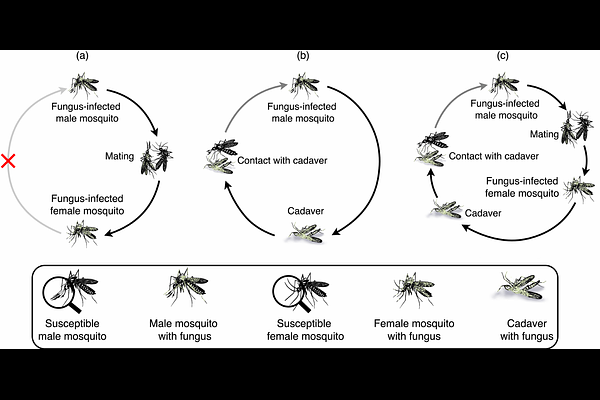Could malaria mosquitoes be controlled by periodic releases of transgenic mosquitocidal Metarhizium pingshaense fungus? A mathematical modeling approach

Could malaria mosquitoes be controlled by periodic releases of transgenic mosquitocidal Metarhizium pingshaense fungus? A mathematical modeling approach
Pant, B.; Bilgo, E.; Mitra, A.; Safdar, S.; Diabate, A.; St. Leger, R.; Gumel, A. B.
AbstractInsect pathogenic fungi offer a promising alternative to chemical insecticides for controlling insecticide resistant mosquitoes. One proposed method involves releasing male Anopheles mosquitoes contaminated with transgenic Metarhizium pingshaense (Met-Hybrid), to lethally infecting females during mating. This study presents a novel deterministic mathematical model to evaluate the impact of this control approach in malaria-endemic areas. The model incorporates two fungus transmission pathways: mating-based transmission and indirect transmission through contact with fungus- colonized mosquito cadavers. We found the fungus cannot establish in the mosquito population without transmission from infected cadavers (in this scenario, the reproduction number of the model is zero). However, if transmission from colonized cadavers is possible, the fungus can persist in the local mosquito population when the reproduction number exceeds one. Simulations of periodic releases of infected male mosquitoes, parameterized using Met-Hybrid-exposed mosquito data from Burkina Faso, show that an 86% reduction in the local female mosquito population can be achieved by releasing 10 Met-Hybrid- exposed male mosquitoes per wild mosquito every three days over six months. This matches the efficiency of some genetic mosquito control approaches. However, a 90 reduction in the wild mosquito population requires, for instance, daily releases of the fungal-treated mosquitoes in a 6:1 ratio for about 5 months, proving less efficient than some genetic approaches. This study concludes that fungal programs with periodic releases of infected males may complement other methods or serve as an alternative to genetic-based mosquito control methods, where regulatory, ethical, or public acceptance concerns restrict genetically-modified mosquito releases.